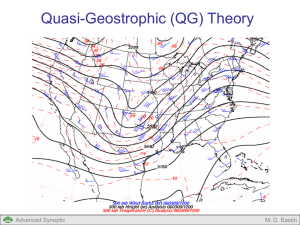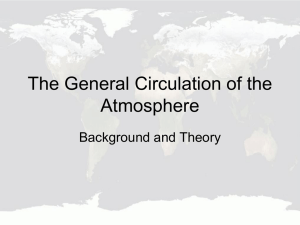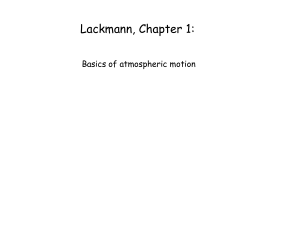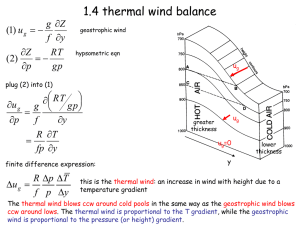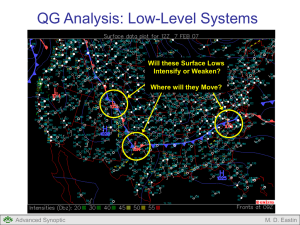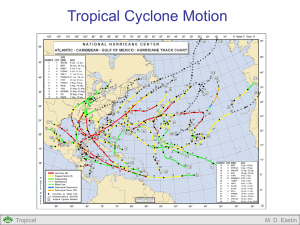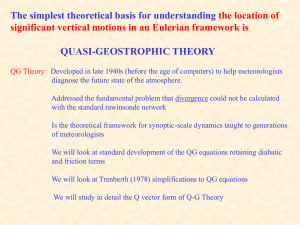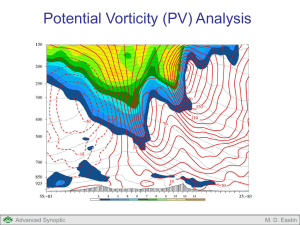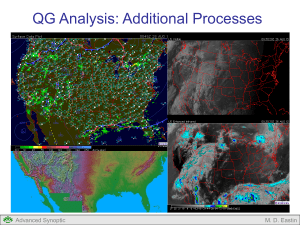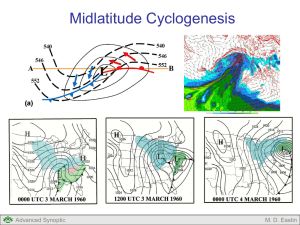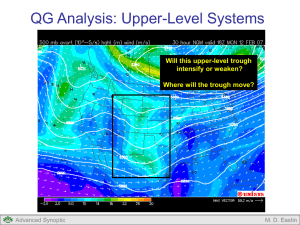QG Analysis
advertisement
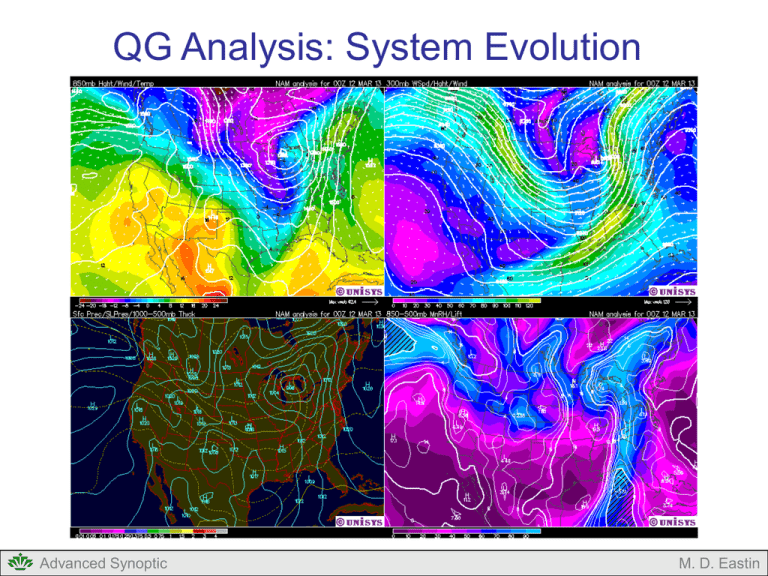
QG Analysis: System Evolution Advanced Synoptic M. D. Eastin QG Analysis QG Theory • Basic Idea • Approximations and Validity • QG Equations / Reference QG Analysis • Basic Idea • Estimating Vertical Motion • QG Omega Equation: Basic Form • QG Omega Equation: Relation to Jet Streaks • QG Omega Equation: Q-vector Form • Estimating System Evolution • QG Height Tendency Equation • Diabatic and Orographic Processes • Evolution of Low-level Cyclones • Evolution of Upper-level Troughs Advanced Synoptic M. D. Eastin QG Analysis: Basic Idea Forecast Needs: • The public desires information regarding temperature, humidity, precipitation, and wind speed and direction up to 7 days in advance across the entire country • Such information is largely a function of the evolving synoptic weather patterns (i.e., surface pressure systems, fronts, and jet streams) Forecast Method: Kinematic Approach: Analyze current observations of wind, temperature, and moisture fields Assume clouds and precipitation occur when there is upward motion and an adequate supply of moisture QG theory QG Analysis: • Vertical Motion: Diagnose synoptic-scale vertical motion from the observed distributions of differential geostrophic vorticity advection and temperature advection • System Evolution: Predict changes in the local geopotential height patterns from the observed distributions of geostrophic vorticity advection and differential temperature advection Advanced Synoptic M. D. Eastin QG Analysis: A Closed System of Equations Recall: Two Prognostic Equations –Two Unknowns: • We defined geopotential height tendency (X) and then expressed geostrophic vorticity (ζg) and temperature (T) in terms of the height tendency. t g t T t g t 1 2 t f 0 p p t R p R p Vg ( g f ) f 0 p T p Vg T t R Advanced Synoptic 1 2 f0 g 1 2 f0 T p R p 1 1 2 Vg 2 fo fo f f0 p p p p Vg R p R R p M. D. Eastin QG Analysis: System Evolution The QG Height Tendency Equation: We can also derive a single prognostic equation for X by combining our modified vorticity and thermodynamic equations (the height-tendency versions): 1 1 2 Vg 2 fo fo f f0 p p p p Vg R p R p R Vorticity Equation Adiabatic Thermodynamic Equation To do this, we need to eliminate the vertical motion (ω) from both equations Step 1: 2 f Apply the operator 0 R to the thermodynamic equation p p Step 2: Multiply the vorticity equation by f 0 Step 3: Add the results of Steps 1 and 2 After a lot of math, we get the resulting prognostic equation…… Advanced Synoptic M. D. Eastin QG Analysis: System Evolution The QG Height Tendency Equation: 2 f 02 2 2 p 1 f o Vg 2 fo f o2 f V g p p • This is (2.32) in the Lackmann text • This form of the equation is not very intuitive since we transformed geostrophic vorticity and temperature into terms of geopotential height. • To make this equation more intuitive, let’s transform them back… g 2 f 02 2 2 p Advanced Synoptic 1 2 f0 T f o Vg g f p R p f o2 R V T g p p M. D. Eastin QG Analysis: System Evolution The BASIC QG Height Tendency Equation: 2 f 02 2 2 p Term A f o Vg g f f o2 R V T g p p Term B Term C • To obtain an actual value for X (the ideal goal), we would need to compute the forcing terms (Terms B and C) from the three-dimensional wind and temperature fields, and then invert the operator in Term A using a numerical procedure, called “successive over-relaxation”, with appropriate boundary conditions • This is NOT a simple task (forecasters never do this)….. Rather, we can infer the sign and relative magnitude of X simple inspection of the three-dimensional absolute geostrophic vorticity and temperature fields (forecasters do this all the time…) Thus, let’s examine the physical interpretation of each term…. Advanced Synoptic M. D. Eastin QG Analysis: System Evolution The BASIC QG Height Tendency Equation: 2 f 02 2 2 p Term A f o Vg g f Term B f o2 R V T g p p Term C Term A: Local Geopotential Height Tendency This term is our goal – a qualitative estimate of the synoptic-scale geopotential height change at a particular location • For synoptic-scale atmospheric waves, this term is proportional to –X • Thus, if we incorporate the negative sign into our physical interpretation, we can just think of this term as local geopotential height change Advanced Synoptic M. D. Eastin QG Analysis: System Evolution The BASIC QG Height Tendency Equation: 2 f 02 2 2 p f o Vg g f Term A f o2 R V T g p p Term B Term C Term B: Geostrophic Advection of Absolute Vorticity (Vorticity Advection) Recall for a Single Pressure Level: • Positive vorticity advection (PVA) causes local vorticity increases PVA → g t 0 • From our relationship between ζg and χ, we know that PVA is equivalent to: g t 1 2 p therefore: PVA → 2p 0 f0 or, since: 2 PVA → 0 Thus, we know that PVA at a single level leads to height falls Using similar logic, NVA at a single level leads to height rises Advanced Synoptic M. D. Eastin QG Analysis: System Evolution The BASIC QG Height Tendency Equation: Term B: Geostrophic Advection of Absolute Vorticity (Vorticity Advection) Initial Time Trough Axis Initial Time Full-Physics Model Analysis NVA PVA Expect Height Rises Expect Height Falls Expect the trough to move east Advanced Synoptic M. D. Eastin QG Analysis: System Evolution The BASIC QG Height Tendency Equation: Term B: Geostrophic Advection of Absolute Vorticity (Vorticity Advection) 12 Hours Later Advanced Synoptic Trough Axis Initial Time Generally consistent with expectations! M. D. Eastin QG Analysis: System Evolution The BASIC QG Height Tendency Equation: Term B: Geostrophic Advection of Absolute Vorticity (Vorticity Advection) Generally Consistent…BUT…Remember! • Only evaluated one level (500mb) → should evaluate multiple levels • Used full wind and vorticity fields → should use geostrophic wind and vorticity • Mesoscale-convective processes → QG focuses on only synoptic-scale (small Ro) • Condensation / Evaporation → neglected diabatic processes • Did not consider differential temperature (thermal) advection (Term C)!!! Application Tips: Often the primary forcing in the upper troposphere (500 mb and above) • Term is equal to zero at local vorticity maxima / minima • If the vorticity maxima / minima are collocated with trough / ridge axes, (which is often the case) this term cannot change system strength by increasing or decreasing the amplitude of the trough / ridge system Thus, this term is often responsible for system motion [more on this later…] Advanced Synoptic M. D. Eastin QG Analysis: System Evolution The BASIC QG Height Tendency Equation: 2 f 02 2 2 p Term A f o Vg g f f o2 R V T g p p Term B Term C Term C: Vertical Derivative of Geostrophic Temperature Advection (Differential Thermal Advection) • Consider a three layer atmosphere where the warm air advection (WAA) is strongest in the upper layer Z-top WAA WAA WAA ΔZ ΔZ increases Z-400mb Z-700mb Height Falls occur below the level of maximum WAA Z-bottom • The greater temperature increase aloft will produce the greatest thickness increase in the upper layer and lower the pressure surfaces (or heights) in the lower levels Therefore an increase in WAA advection with height leads to height falls Advanced Synoptic M. D. Eastin QG Analysis: System Evolution The BASIC QG Height Tendency Equation: 2 f 02 2 2 p f o Vg g f Term A f o2 R V T g p p Term B Term C Term C: Vertical Derivative of Geostrophic Temperature Advection (Differential Thermal Advection) • Possible height fall scenarios: Strong WAA in upper levels Weak WAA in lower levels WAA in upper level CAA in lower levels No temperature advection in upper levels CAA in lower levels Weak CAA in upper levels Strong CAA in lower levels Advanced Synoptic M. D. Eastin QG Analysis: System Evolution The BASIC QG Height Tendency Equation: 2 f 02 2 2 p Term A f o Vg g f f o2 R V T g p p Term B Term C Term C: Vertical Derivative of Geostrophic Temperature Advection (Differential Thermal Advection) • Consider a three layer atmosphere where the warm air advection (CAA) is strongest in the upper layer CAA CAA CAA ΔZ Z-top ΔZ decreases Z-400mb Z-700mb Height rises occur below the level of maximum CAA Z-bottom • The greater temperature increase aloft will produce the greatest thickness increase in the upper layer and lower the pressure surfaces (or heights) in the lower levels Therefore an increase in CAA advection with height leads to height rises Advanced Synoptic M. D. Eastin QG Analysis: System Evolution The BASIC QG Height Tendency Equation: 2 f 02 2 2 p f o Vg g f Term A f o2 R V T g p p Term B Term C Term C: Vertical Derivative of Geostrophic Temperature Advection (Differential Thermal Advection) • Possible height rise scenarios: Strong CAA in upper levels Weak CAA in lower levels CAA in upper level WAA in lower levels No temperature advection in upper levels WAA in lower levels Weak WAA in upper levels Strong WAA in lower levels Advanced Synoptic M. D. Eastin QG Analysis: System Evolution The BASIC QG Height Tendency Equation: Term C: Vertical Derivative of Geostrophic Temperature Advection (Differential Thermal Advection) Initial Time 850 mb Initial Trough Axis Full-Physics Model Analysis Strong WWA Weaker WAA aloft (not shown) Expect Height Rises Strong CAA Weaker CAA aloft (not shown) Expect Height Falls Advanced Synoptic M. D. Eastin QG Analysis: System Evolution The BASIC QG Height Tendency Equation: Term C: Vertical Derivative of Geostrophic Temperature Advection (Differential Thermal Advection) 12 Hours Later 850 mb Initial Trough Axis Ridge ”rose” slightly Advanced Synoptic Generally consistent with expectations! Trough “deepened” M. D. Eastin QG Analysis: System Evolution The BASIC QG Height Tendency Equation: Term C: Vertical Derivative of Geostrophic Temperature Advection (Differential Thermal Advection) Generally Consistent…BUT…Remember! • Used full wind field → should use geostrophic wind • Only evaluated one level (850mb) → should evaluate multiple levels/layers ** • Mesoscale-convective processes → QG focuses on only synoptic-scale (small Ro) • Condensation / Evaporation → neglected diabatic processes • Did not consider vorticity advection (Term B)!!! Application Tips: Often the primary forcing in the lower troposphere (below 500 mb) • Term is equal to zero at local temperature maxima / minima Since the temperature maxima / minima are often located between the trough / ridge axes, significant temperature advection (or height changes) can occur at the axes and thus amplify the system intensity Advanced Synoptic M. D. Eastin QG Analysis: System Evolution The BASIC QG Height Tendency Equation: Term C: Vertical Derivative of Geostrophic Temperature Advection (Differential Thermal Advection) Important: You should evaluate the vertical structure of temperature advection!!! Advanced Synoptic M. D. Eastin QG Analysis: System Evolution The BASIC QG Height Tendency Equation: Term C: Vertical Derivative of Geostrophic Temperature Advection (Differential Thermal Advection) Important: You should evaluate the vertical structure of temperature advection!!! N-S Cross-section of Temperature Advection WAA = Warm Colors CAA = Cool Colors Advanced Synoptic M. D. Eastin QG Analysis: System Evolution The BASIC QG Omega Equation: Application Tips: Remember the underlying assumptions!!! You must consider the effects of both Term B and Term C at multiple levels!!! If the vorticity maxima/minima are not collocated with trough/ridge axes, then Term B will contribute to system intensity change and motion If the vorticity advection patterns change with height, expect the system “tilt” to change with time (become more “tilted” or more “stacked”) If differential temperature advection is large (small), then expect Term C to produce large (small) changes in system intensity Opposing expectations from the two terms at a given location will weaken the total vertical motion (and complicate the interpretation)!!! The QG height-tendency equation is a prognostic equation: • Can be used to predict the future pattern of geopotential heights • Diagnose the synoptic–scale contribution to the height field evolution • Predict the formation, movement, and evolution of synoptic waves Advanced Synoptic M. D. Eastin References Bluestein, H. B, 1993: Synoptic-Dynamic Meteorology in Midlatitudes. Volume I: Principles of Kinematics and Dynamics. Oxford University Press, New York, 431 pp. Bluestein, H. B, 1993: Synoptic-Dynamic Meteorology in Midlatitudes. Volume II: Observations and Theory of Weather Systems. Oxford University Press, New York, 594 pp. Charney, J. G., B. Gilchrist, and F. G. Shuman, 1956: The prediction of general quasi-geostrophic motions. J. Meteor., 13, 489-499. Durran, D. R., and L. W. Snellman, 1987: The diagnosis of synoptic-scale vertical motionin an operational environment. Weather and Forecasting, 2, 17-31. Hoskins, B. J., I. Draghici, and H. C. Davis, 1978: A new look at the ω–equation. Quart. J. Roy. Meteor. Soc., 104, 31-38. Hoskins, B. J., and M. A. Pedder, 1980: The diagnosis of middle latitude synoptic development. Quart. J. Roy. Meteor. Soc., 104, 31-38. Lackmann, G., 2011: Mid-latitude Synoptic Meteorology – Dynamics, Analysis and Forecasting, AMS, 343 pp. Trenberth, K. E., 1978: On the interpretation of the diagnostic quasi-geostrophic omega equation. Mon. Wea. Rev., 106, 131-137. Advanced Synoptic M. D. Eastin
